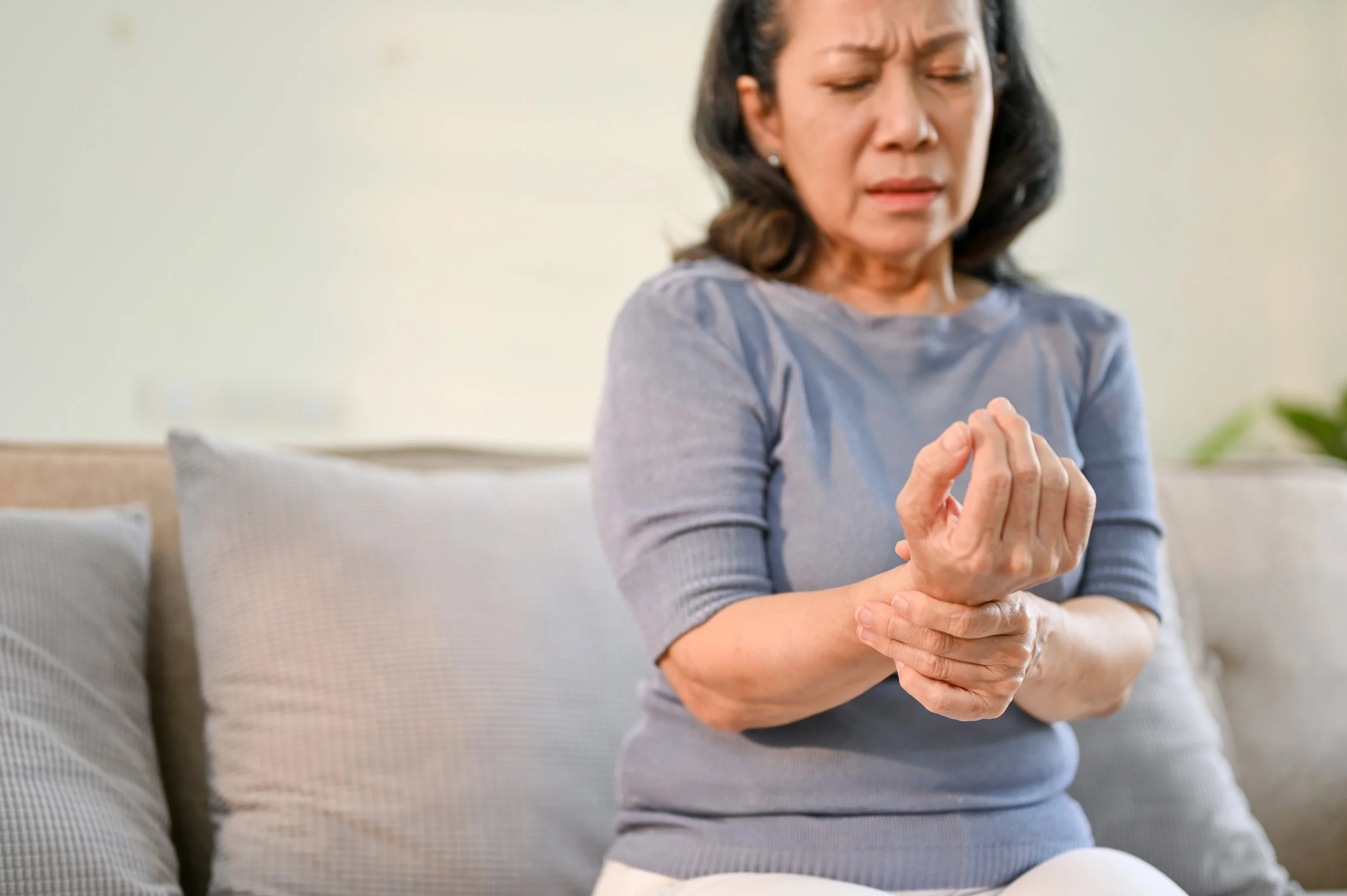Joint Pain & Muscle Aches
Written by Andrea Mazzocchi, PhD | Medically reviewed by Mandy Armitage, MD
Many women entering perimenopause are surprised by new aches and pains in their joints and muscles. While hot flashes and mood swings get more attention, it’s less well-known that over half of women experience joint pain around the time of menopause (1).
Some studies suggest the number may be even higher. A recent analysis found about 71% of perimenopausal women report musculoskeletal pain (2). These aches can range from mild morning stiffness to more persistent joint pain or muscle soreness. Here, we explore why these symptoms occur during perimenopause and menopause and how they may change over time.
How common are perimenopause or menopausal aches and pains?
While less familiar than other symptoms like hot flashes or night sweats, joint and muscle pains are very common symptoms during perimenopause. Research indicates that the majority of women (over 70%) will experience some form of muscle or joint discomfort as they go from perimenopausal to postmenopausal, and roughly 25% of women find these symptoms severe enough to interfere with daily life (3).
In other words, this achiness isn’t just “in your head” - it’s real and prevalent. Doctors have observed this phenomenon for over a century (the term “menopausal arthritis” dates back to the 1920s), but only recently are we understanding the hormonal links behind it (4). The good news is that by recognizing joint pain as a perimenopause-related symptom, women can seek proper guidance and not feel alone in what they’re experiencing.
How do hormone changes in perimenopause cause joint pain and muscle aches?
The root of these aches are likely due to the hormonal turbulence of perimenopause. In early perimenopause – when hormones are starting to fluctuate, some women notice occasional joint twinges or muscle pains that come and go. As perimenopause progresses and estrogen levels begin to swing more unpredictably, aches may become more frequent. Research indicates that joint pain and muscle ache tend to peak in prevalence during perimenopause (2). Many women in this stage report waking up with stiff joints or new aches in the neck, shoulders, or knees that they haven’t experienced before. Estrogen (along with progesterone and even testosterone) plays a protective role in our muscles and joints. Researchers haven’t pinpointed an exact cause for this, but most research points to hormone changes. In some situations, estrogen acts as an anti-inflammatory agent (5). In fact, there are estrogen receptors in joint tissues (like cartilage cells), meaning estrogen may directly influence joint health and cartilage maintenance (6). When estrogen levels fluctuate and ultimately fall during perimenopause and menopause, increased inflammation, stiffness, and pain in the muscles and joints can be triggered (7).
Declining estrogen also contributes to other physical changes that underlie these aches. For example, lower estrogen can lead to loss of muscle mass and strength (also known as sarcopenia) and a more rapid drop in bone density (8). With weaker muscles and bones, the joints have less support and may experience more strain. In short, the hormonal shifts of midlife can create a perfect storm - decreased estrogen leaving joints less protected (chemically and structurally), which can result in pain. The sensation can manifest as generalized muscle soreness, joint aching or stiffness, and tendon pain in various parts of the body (9).
Tracking your symptoms and hormones with Play Health can help you make sense of the symptoms you’re experiencing during perimenopause.
-
Blumer J. Arthralgia of menopause – A retrospective review. Post Reprod Health. 2023;29(2):95-97. doi:10.1177/20533691231172565
Lu C, Liu PF, Zhou YS, et al. Musculoskeletal pain during the menopausal transition: A systematic review and meta-analysis. Neural Plast. 2020;2020:8842110. doi:10.1155/2020/8842110
Wright VJ, Schwartzman JD, Itinoche R, Wittstein J. The musculoskeletal syndrome of menopause. Climacteric. 2024;27(5):466-472. doi:10.1080/13697137.2024.2380363
Cecil RL, Archer BH. Arthritis of the menopause: A study of fifty cases. 1925;84(2):75–79. doi:10.1001/jama.1925.02660280001001
Straub RH. The complex role of estrogens in inflammation. Endocr Rev. 2007;28(5):521-574. doi:10.1210/er.2007-0001
Richette P, Corvol M, Bardin T. Estrogens, cartilage, and osteoarthritis. Joint Bone Spine. 2003;70(4):257-262. doi:10.1016/S1297-319X(03)00067-8
Magliano M. Menopausal arthralgia: Fact or fiction. Maturitas. 2010;67(1):29-33. doi:10.1016/j.maturitas.2010.04.009
Lu L and Tian L. Postmenopausal osteoporosis coexisting with sarcopenia: the role and mechanisms of estrogen. J Endocrinol. 2023;259(1). doi.org/10.1530/JOE-23-0116 .
Dugan SA, Powell LH, Kravitz HM, Everson Rose SA, Karavolos K, Luborsky J. Musculoskeletal pain and menopausal status. Clin J Pain. 2006;22(4):325-331. doi:10.1097/01.ajp.0000208249.07949.d5

